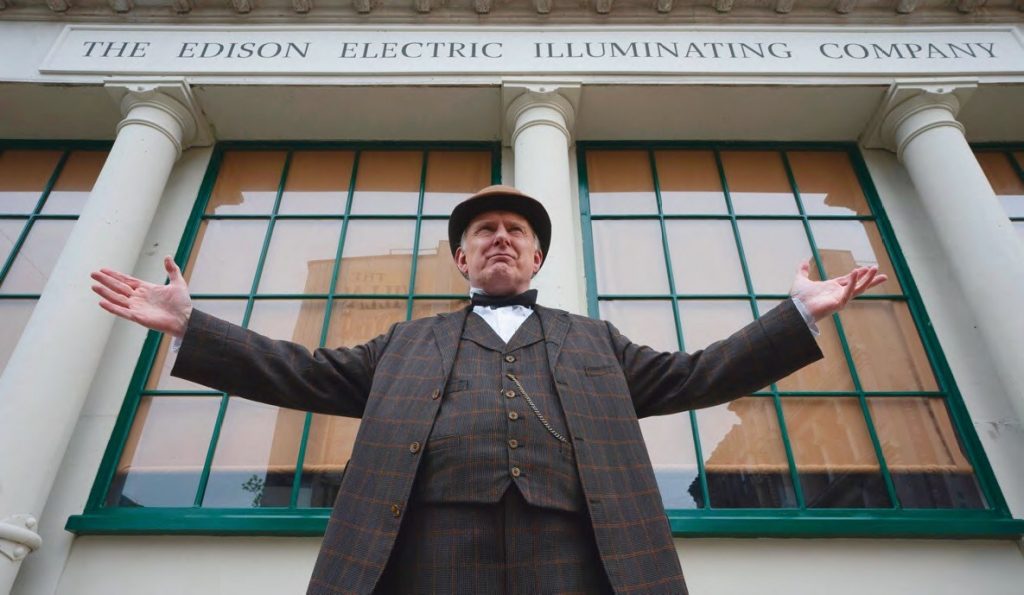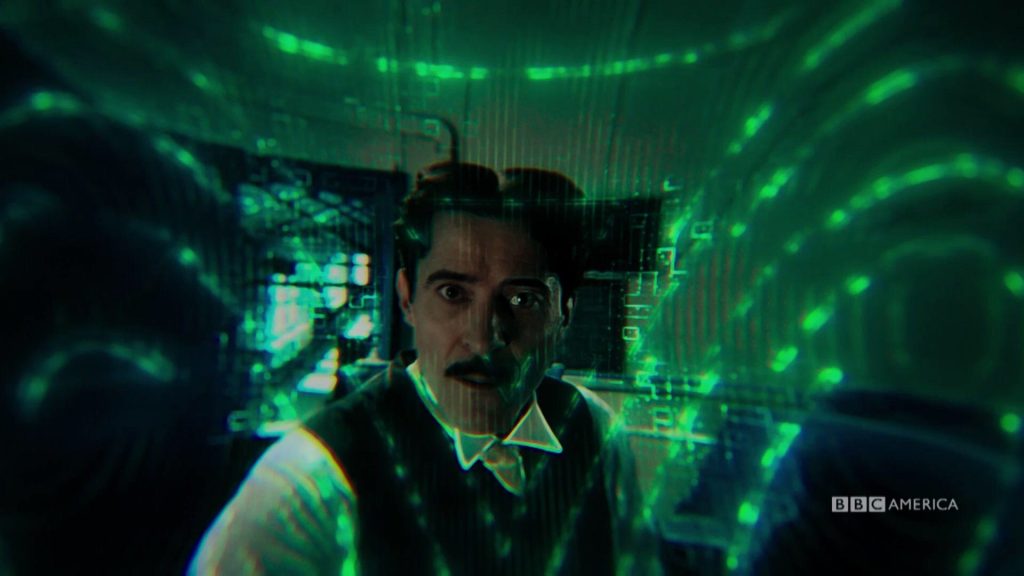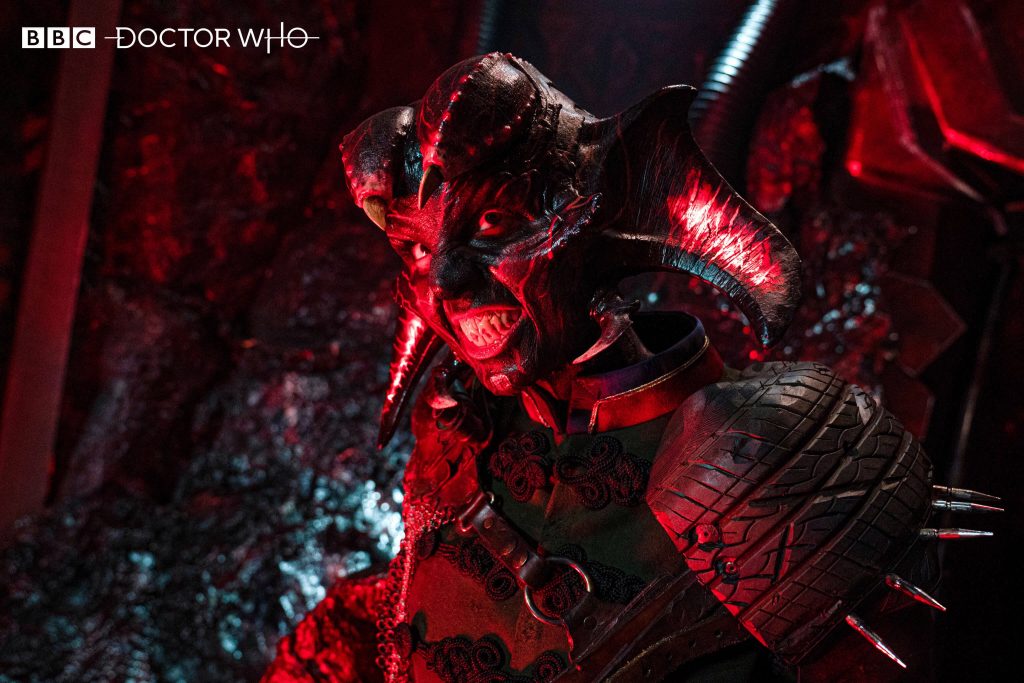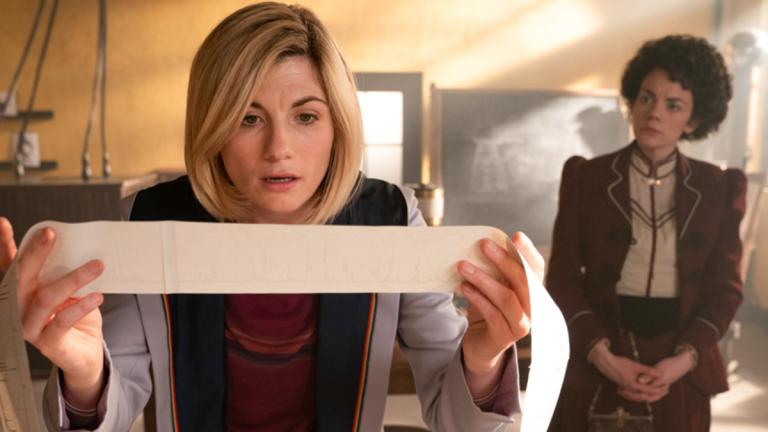
Image: BBC
Reviewed by Paul Mount
WARNING: Spoilers Ahead
Written by: Nina Metivier
Directed by: Nida Manzoor
First Broadcast: 19th January 2020 – BBC One
1903. Who or what is sabotaging Nikola Tesla’s generator plant at Niagara Falls? And has this maverick inventor really received a message from Mars?
Doctor Who has always enjoyed a cheerful and occasionally slapdash relationship with the tropes and traditions of time travel storytelling. In the early days of the show, the Doctor and his companions would wander through the corridors of Time, pitching up at moments of historical importance (on the planet Earth, of course – who knows what rules apply to time travel on alien planets?), delicately interfering with the course of history yet managing not to trigger the Butterfly Effect more by luck than judgment.
In 1964, in The Aztecs, the first Doctor (William Hartnell) testily told his companion Barbara that “you can’t rewrite history, not one line” when she attempted to interfere for the sacrificial traditions of an ancient culture. In the rebooted 21st century series, Russell T Davies went to great pains to create the concept of ‘fixed points in Time’, moments in the space-time continuum of pivotal cosmic importance that were set in stone and could never be changed.
This allowed writers a certain amount of elbow-room in crafting stories set in some recognisable past where the Doctor’s arrival would otherwise be almost bound to change the recognised course of events but also required them to work a bit harder when writing stories set in the past (and even the future) to ensure that nothing they were doing was likely to invoke the new Fixed Point rule or if was invoked then it was essential that it didn’t stifle the creativity of the story.
When ‘pure’ historical stories fell out of favour in the 1960s – the audiences had come to see the latest rubber monsters, not a bunch of earnest actors in wigs and cloaks sweeping about the place – the Doctor’s voyages into the past tended to tell a story set in some vague period of history where the Doctor became involved in events set in the past without featuring any recognisable historical characters but focussing on some outlandish science-fiction gimmick or motif. These stories came to be called ‘pseudo-historicals’ and some of the show’s finest classic serials make use of this format to great effect.
Russell T Davies quickly decided that if the Doctor was going to be a time traveller then he was going to meet actual, real-life People From History in stories that would broadly follow the Reithian BBC principle of educating, informing and entertaining. In the course of its first few years back on screen the Doctor was rubbing shoulders with Charles Dickens, Queen Victoria, William Shakespeare and Agatha Christie and, under Steven Moffat, caricatures of the likes of Winston Churchill and Queen Nerfertiti.
Chris Chibnall’s Who has aimed for more of a halfway house; the Doctor’s going to travel in Time but she’s not going to meet the historical big-hitters. No, the focus latterly has been on unsung heroes, people who achieved great things (or even strive to achieve great things) but without becoming historical poster boys and girls and sometimes having been forgotten altogether.
Season 12 has already introduced us to 19th century computer pioneer Ada Lovelace and 21st century wartime spy Noor Inayat Khan and the luridly-titled Nikola Tesla’s Night of Terror, promising debut script from newcomer Nina Metvier turns its attention to early 20th century inventor Nikola Tesla, his real-life assistant Dorothy Skerrit and Tesla’s ruthless glory-seeking competitor, Thomas Edison.

Image: BBC
But this is no dry, preachy polemic on scientific achievement and ambition (well, not all the time…); there is, of course, a race of scavenging alien scorpion creatures lurking in the background, keen to exploit Tesla’s genius even as it is being smothered by Edison. This is still Doctor Who after all.
Nikola Tesla’s Night of Terror is great rollicking fun. Metvier’s script is nimble and fleet-footed, action sequences rattle along, never at the expense of the story (a fault which scuppered Orphan 55) and there’s time for characters to stop and talk, to live and breathe and dream.

Image: BBC
Goran Visnic plays Tesla with a real understated passion. He’s a man of huge ambition, determination and imagination but he’s thwarted and frustrated at every turn by the fact that people don’t believe in him enough to give him a chance.
The tragedy is that the Doctor knows his ultimate fate – as does the audience by the end of the episode – and yet we still feel that he is a man with so much potential, a man capable of so many great things (and whose fingerprints are, in fact, discretely laced through many of the marvels we take for granted in today’s world) if only he can find someone rich enough and philanthropic enough to fund his experiments.
As we discover, the ruthless Edison is not to be that man…
The episode kicks off with a very welcome long establishing Doctor-less sequence where Tesla is making a presentation at the Niagara Falls where he is attempting to encourage investment for his new wireless transmission system. Working late on his generator he comes across a strange floating glowing orb. Sensing that it is potentially dangerous he flees with his assistant Dorothy Skerrit just as a mysterious cloaked figure appears and shoots at them with a futuristic weapon.
Enter the Doctor having responded to an unusual energy signature, and soon the trio – along with the Doctor’s trusty fam (ouch!) are aboard a train heading towards New York where they are again attacked by creepy potential assassins bearing impossible weapons. They escape their tormentors by detaching their carriage and arrive in New York to find that Thomas Edison (Robert Glenister, returning to Doctor Who after a thirty-six year absence) has been cultivating a climate of fear against Tesla and his inventions.

Image: BBC
The Doctor suspects that Edison is somehow behind the attacks until she is transported aboard an invisible spaceship hovering above the city. Inside lurk the Skithra, vicious arachnid creatures led by their maniac Queen (played by Anjli Mohindra returning to the Whoniverse following her run as Rani Chandra in popular spin-off The Sarah Jane Adventures).
The Skithra are cosmic scavengers, their ship and their entire technology stolen from other civilisations, who plan to exploit Tesla’s work – having previously made contact with the scientist when he picked up a signal from their ship when working on his wireless power system.
The Skithra threaten to destroy the Earth if Tesla is not surrendered to them and as the creatures begin to swarm across the city, the Doctor has to race against time to find a way to stave off the invasion… and the solution may just lie at Tesla’s famous Wardenclyffe Tower where he carried out many of hisn experiments on wireless transmission.
Nikola Tesla’s Night of Terror is as rambunctious and joyous a piece of pseudo-historical Doctor Who fluff as it might be possible to imagine. It’s also a welcome and rapid return to form after the stumble of Orphan 55, fizzing and crackling with the same energy and enthusiasm as season opener Spyfall (albeit without such potentially game-changing repercussions for the series as a whole), delivering on a checklist of classic Doctor Who standards.
We have a beautifully-realised historical setting, nicely-played characters from history who are actually allowed to behave like real people, and a vividly-realised new race of nasty aliens. (The Skithra are terrifically animated – only the Queen herself disappoints, depicted as an all-too-obvious costume and with a performance clearly informed by Sarah Parish’s turn as the Empress of the Racnoss in 2006’s The Runaway Bride).
All that said, on occasion, the episode does suffer from the familiar problem of perhaps just slightly too much garbled exposition still characterising the ’tell don’t show’ problem blighting the scripts for this latest season.

Image: BBC
Jodie Whittaker’s performance is as bright-eyed and breathless as ever. While there are still few signs of any great individuality in her Doctor, she’s certainly being given meatier material to work with this year. Her Doctor has some genuinely nasty adversaries to lock horns with, enabling her to add a layer of steel to her characterisation.
In many ways Nikola Tesla’s Night of Terror is a by-the-numbers monster-of-the-week romp, but the setting alone and some of the subtleties of the script, such as the clever and understated similarities between the scavenging Skithra keen to exploit Tesla’s genius and Edison, equally seeking the glory of the fruits of the great man’s mind, are nicely played, alongside a real freewheeling joie de vivre in the entire production, set the episode way above many of its type which pepper the show’s oeuvre and impressively continues to remarkable uptick in Doctor Who’s creative fortunes this year.
On then, to episode five, and the return of Tennant-era favourites the Judoon, who are rampaging across Gloucester in search of a mysterious fugitive. Who can it be?
Paul Mount
• Pre-order Doctor Who: The Complete Series 12 (2020) from AmazonUK (Affiliate Link)
WEB LINKS
• Doctor Who – Nikolai Tesla’s Night of Terror – BBC
Doctor Who © BBC Studios
Dear Readers: A review is an opinion. Other opinions are available
One of many guest posts for downthetubes.
Categories: Doctor Who, downthetubes News, Features, Other Worlds, Reviews
 In Review: Timeslides: The Doctor Who Artwork of Colin Howard
In Review: Timeslides: The Doctor Who Artwork of Colin Howard  In Review: The Illustrated Journey: A Visual Celebration of Doctor Who
In Review: The Illustrated Journey: A Visual Celebration of Doctor Who  Doctor Who: Worlds of Wonder Exhibition
Doctor Who: Worlds of Wonder Exhibition  Panini releases second “Daleks: The Ultimate Comic Strip Collection”
Panini releases second “Daleks: The Ultimate Comic Strip Collection”
Excellent episode & writing. Fun with solid historical base. Sentimentally, the Tesla tower, which failed in reality, was redeemed as it delivered at the climax. Just needed more Tesla coils. The real Wardenclyffe is now a museum.
But Doctor Who has solved the Time Traveller’s paradox, in that the impact of time travel is linear cause & effect. The Doctor’s interventions are already part of our history. The unwritten future can be changed, i.e. the outcome of the episode, but the written future, our past, is fixed. Our past is the result of the Doctor’s meddling, while the meddling itself may occur in our future. Consider the typical episode: the Doctor arrives at some unusual setting. Mysterious deaths occur. The Doctor triumphs & moves on. Yet never does the Doctor then travel back to the start of the adventure, fix the problem & prevent the mysterious deaths. The future is not rewritten.
Since the companions are alive at the end of Spyfall, the Doctor can travel back & save them. The future is not rewritten. Orphan 55 introduced the more dubious alternative timelines, the possibility of rewriting the future. In order to include the swipe of the underground station scene from Beneath the Planet of the Apes (1970).
Problem with the above is that it leads to fatalism. Sit back & do nothing, it’ll all be OK. So the future, & indeed the past, needs to be rewritable or there is no tension. Where’s the Delete button?